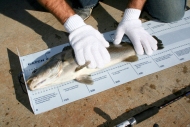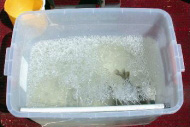
Ideas to improve your fishing event




There are many different ways that fishing events can be improved, some examples are given below:
- Introduce species-based awards, rather than aggregate weights of fish to discourage people from taking more fish than they need.
- Reduce the number of species eligible in the competition to popular or common table species to discourage people from taking fish they wouldn’t normally utilise.
- Increase the size limits for eligible fish.
- Reduce bag limits (including incidentally caught fish).
- Display an up-to-date scoreboard to reduce the take and presentation of unnecessary fish for recording.
- Initiate gear restrictions to maximise fish survival, examples include:
- Lure only, circle hook only, barbless hook only, knotless landing nets etc
- Introduce catch and release format:
- Buddy system, photo validation, live weigh/measure of fish
- Improve catch and release events:
- If you require participants to hold fish - require flow through live wells etc.
- Reduce holding time of fish by using increased numbers of stewards.
- Limit the number of competitors - reducing total impact by reducing total effort or capping effort
- Consider timing event and location of fishing area to minimise impact:
- Account for potential fish barotrauma issues in deeper water, limit impact on breeding aggregations, avoid known locations of protected/ threatened species, consider other users of boat ramps etc.
Are you considering introducing catch and release to your fishing event?
Catch and release can make up the format of the whole event or a component of the event. There are a number of formats that can be considered:
- Catch and release of all species.
- Catch and release for certain species.
- Catch and release for junior anglers.
- Catch and release for one day of the event.
- Optional catch and release by allowing fish to be weighed in alive.
Once you have chosen the best format to suit your event, you need to decide what the event rules will be.
Catch and release with photo validation
This involves the use of video or digital camera to validate and judge the largest species released. Competitors use cameras and measuring mats to capture a clear photograph showing the length of their fish immediately after capture. The fish needs to be located on the mat so that its nose is placed against the end and the tail clearly showing the measurement underneath. The best feature of this method is that the fish is released immediately after its measurement is recorded and photographed. Only the competitors reporting the largest fish need supply their images for validation by the judges.
Cameras can also be used to demonstrate the release of large game fish. This usually requires a unique tournament card to be held up in shot whilst the fish is being released.
Catch and release - buddy system
The “buddy system” (where a fishing companion or another competitor witnesses the capture, recording and release of a fish) is widely used. This requires the accurate placement of fish on catch and release (brag) mats to verify the measurement. The fish may be released immediately after the recording has been witnessed.
Catch and release - marshals
Marshals may be used to validate the recording of any caught fish. This event format is best if the marshals are mobile and able to travel to the angler to reduce the holding time of the captured fish. However, promoting regular return to static marshals is popular and has minimal impact on the fish as long as the holding tank is of sufficient standard so that the fish arrive to the marshals in a vigorous and live state (it may be appropriate to disqualify fish that are sick or dead at the marshal station to promote best care practices of the fish.)
Tag and release
Another method that can be adopted for gamefish species which allows immediate release of fish is the use of specially developed tags, where points are scored for every fish that is successfully tagged and released. For more information see our game fish tagging program page.
For information regarding catch and release fishing techniques see our catch and release page.

